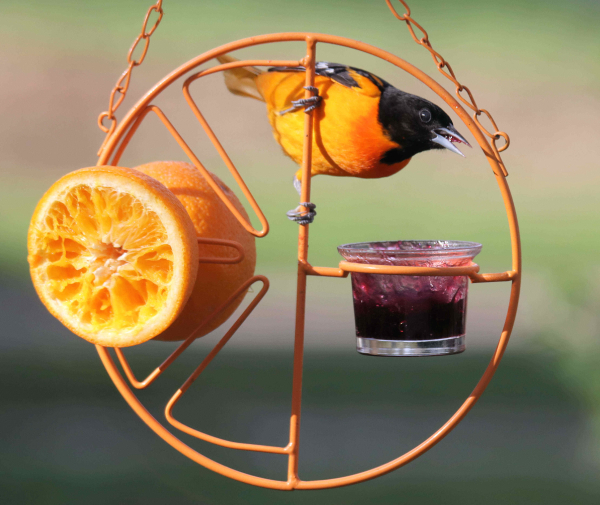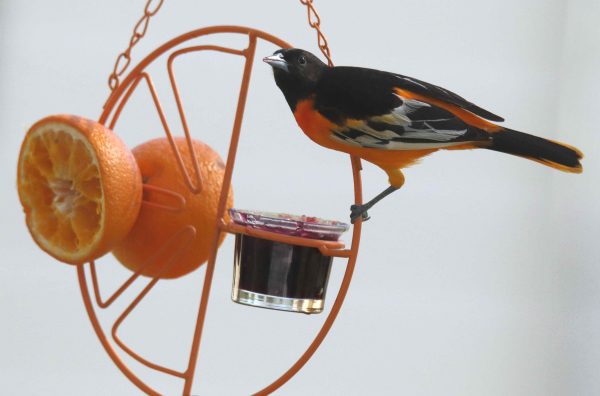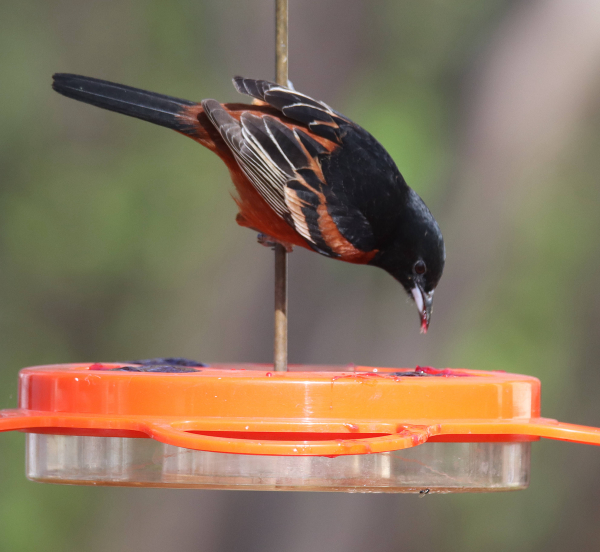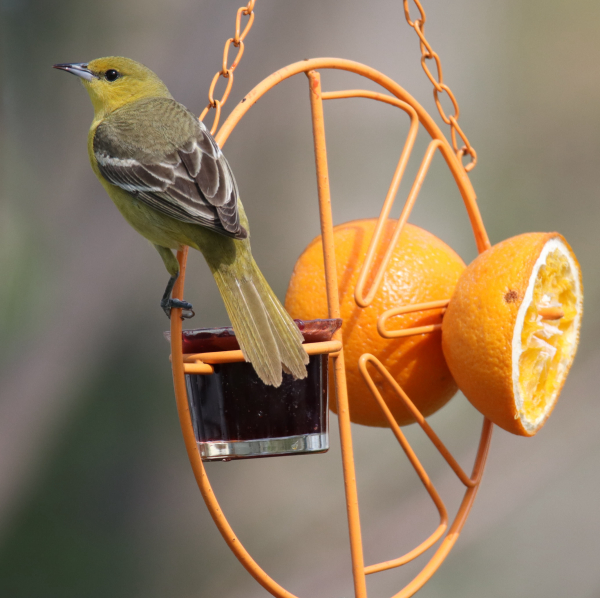
The first day when orioles arrived at Paul’s oriole feeder – Friday – marked the beginning of the summer bird feeding season.

The return of the unique white-winged Baltimore Oriole was a remarkable surprise. The vocal oriole continues to visit the feeder as of publishing time Tuesday afternoon. Will it spend the summer?

A male Orchard Oriole feeds on grape jelly from the new Oriole feeder, which also contains sugar-water nectar.

The backside portrait of a female Orchard Oriole provides an elegant look at her as she arrives at the feeder, which Paul refers to as the “circus feeder” because it requires a level of balance and stretching while birds perch on a non-horizonal structure.
|
We turned this week’s backyard article over to our editor, who has been anticipating the arrival of the first orioles of the season with heightened levels of excitement. Paul wrote: I’ve been ready for the return of orioles since last fall when I finally removed my oriole feeders and cleaned them thoroughly for winter storage. Knowing their usual mid-May arrival was closing in, I bought fresh oranges and a squeeze-bottle of grape jelly last Thursday, but considering 2 days of rain were forecast through May 13, I figured it might be a couple days early to add the oriole foods to my feeding station, only to get them rain-soaked.
After awakening to the sound of rainfall Friday, I figured I’d wait to add the oriole goodies until Sunday, Mother’s Day, when the rainy days would break during early morning. Shortly after I began working on this issue of The Birding Wire, I looked up from my desk to see the bright yellow color of a male American Goldfinch in full color perched on a shepherd’s crook above a feeder. I felt sorry the feeder wasn’t filled with thistle seeds, but took the prompt and added some thistle seeds to a feeder to see if I could entice goldfinches without attracting starlings, House Sparrows, and grackles – then returned to work.
A short time later, I noticed a small bird behaving like a foraging warbler, high in a distant elm tree. I took a look through binoculars and identified it as a tiny Orange-crowned Warbler foraging for small insects among the sticky new leaf and flower buds. Perhaps the rain had short-stopped some migrating warblers, or maybe the warblers arrived early this morning before the rain; but then again, one warbler does not make a migration. Even so, the goldfinch and warbler put me on a higher level of alert, so while writing and editing I periodically took a quick look outside my bay windows.
Not long thereafter, another slightly larger bird caught my attention in about the same location where I saw the warbler. Raising my binoculars, the 8-power optics revealed a yellow female Orchard Oriole – WoW, what a fun surprise – the first oriole of the year! I checked for other birds, then promptly resurrected my primary oriole feeder, grabbed an orange that I sliced in half and attached the 2 half-oranges to the feeder’s spikes; then squeezed grape jelly into the small bowl in the feeder, and hung the feeder in the primary position at my feeding station. With 3 new foods added – thistle seeds, grape jelly, and sliced oranges, I settled back into my office chair.
I resumed writing, not anticipating any immediate action at the oriole feeder, or at the thistle feeder for that matter, but now I was prepped and ready. Suddenly, just 4 minutes later – bingo – the first Baltimore Oriole landed on the oriole feeder, and a moment later the colorful male was eating grape jelly! This day only comes once a year, when orioles suddenly appear, so it was a moment to remember – to document. I reached for my camera, made a quick adjustment, and photographed the first oriole at my feeder this spring. I never would have guessed an oriole would appear so quickly; did it actually see me hang the feeder in position to respond so immediately?
A dozen or so minutes later, as I checked weather radar for the next shower, the radar map showed that it should be raining outside. When I looked up, indeed it was sprinkling, and suddenly a male Baltimore Oriole landed at the feeder to eat jelly, and before taking flight the oriole began singing a familiar and beautiful melody, which it continued to sing from a nearby perch – how wonderful.
Almost exactly 1 hour after adding my oriole feeder to my feeding station, voila, an adult male Orchard Oriole arrived, fed on the jelly, and lingered for an extended period. It seemed tired, closing its eyes often as it perched on the feeder just above the jelly bowl. It fed again, rested a short time, fed a third time, then left – pretty exciting. The Orchard Oriole returned periodically – a recognizable presumably older adult male that showed wear on its body feathers. An adult male Baltimore Oriole, or more than one, fed at the feeder periodically too.
Returning to my editing, 80-some minutes after adding the thistle seed to my feeding station I looked up to see a female American Goldfinch was feeding, a great bonus – I was 2 for 2 after adding the new bird foods – or was that 3 for 2, considering 2 oriole species were using the oriole feeder. About a half-hour later, a female goldfinch was present again, and a male quickly joined her for thistle seeds. Thereafter, I noticed goldfinches at the feeder about every 30 or 40 minutes. At one point, I also saw a pair of House Finches perched at the thistle feeder, providing an added touch of color to the action.
With such great luck attracting new birds to my feeding station with newly added foods, I finally decided I better fill my hummingbird feeder with sugar-water nectar and add it to the mix. I fully intended to have my oriole feeder and hummingbird feeder ready and waiting a couple days before orioles and hummingbirds arrived, but even the best laid plans sometimes fall a few minutes or hours short – or maybe it was right on time, or 4 minutes early – ha. The light wind was blowing east-southeast, so it was a perfect situation for a fallout of migrating songbirds to be stopped by the morning rainfall. But the east wind switched about 2 hours later to a northeast wind, which would likely hold any new arrivals in this location for a while.
That afternoon, I used by birding optics in a big way, getting clear magnified views of the new birds with my binoculars, which also allowed me to look for distinguishing characteristics that might indicate a given individual – something I tend to specialize in as a biologist, but it also comes in handy when trying to assess the number of songbirds at my feeding station and in my yard. If you haven’t been using your binoculars to observe birds lately, now’s the time to make the most of them – they add a whole new dimension to the birds I monitor out my windows.
At one point later in the afternoon, during a light rain an adult male Baltimore Oriole arrived and ate a bit of jelly, only to be “greeted” by an adult male Orchard Oriole that pressed an attack on the larger Baltimore. The orange guy held its position, forcing the Orchard to perch on an adjacent shepherd’s hook to chatter as the Baltimore fed. But as soon as the Baltimore left the grape jelly jar, the Orchard replaced it in a split-second.
During the next visit, the Orchard Oriole took a bite of jelly before being displaced by a (the) Baltimore Oriole, which ate jelly as the Orchard perched a foot away and chattered. When finished, the Baltimore perched on the feeder just a few inches above the jelly jar, and the seemingly impatient Orchard tried to displace it, but the Baltimore held its position another moment, making the Orchard return to its nearby perch until the Baltimore flew off.
One more oriole interaction included another new bird – a Gray Catbird that arrived at the feeders as the Baltimore was feeding on jelly, and the Orchard was in waiting. When the Baltimore left, the Orchard and catbird zeroed in on the feeder, with the larger catbird even half-spreading its wings as it faced off with the Orchard; but it backed away from the Orchard, then took a turn at the jelly jar next. For the record, the orioles only ate grape jelly, ignoring the oranges, but it probably was the orange color that caught their attention initially. (P.S. the orioles did eat oranges the second afternoon; rarely thereafter.) And did I mention that at one time, as many as 8 goldfinches arrived, including 6 males and 2 females – what an exciting change from the day before when my feeding station was all but lifeless!
Well, I hope my play by play description of the first day when favorite feeder birds arrived after spending the “off-season” in Latin America wasn’t too frivolous. I certainly enjoyed documenting the action and perhaps adding some incentive for anyone who hasn’t added grape jelly and hummingbird nectar to their yard’s avian attractions. These birds are a thrill to see again after 8 months far south, and by providing the foods non-stop from today forward I hope some will stay throughout the nesting season, along with more yet to arrive.
A quick Saturday update: The following morning, with continuing rainfall, at least 7 Orchard Orioles (3 adult males, 1 first-year male, and 3 females) were stopping by for grape jelly, along with at least 8 Baltimore Orioles (4 females, at least 3 typical adult males but probably more; and remarkably, 1 white-winged adult male!) – that’s a minimum of 15 orioles.
The white-winged adult male Baltimore Oriole is an exceptional individual for 2 reasons! First, this male shows a slight level of albinism in that some feathers on its left wing are pure white, some are partly white. This makes it a partial albino, or leucistic Baltimore Oriole. The unique white coloration on the wing also makes it readily identifiable – it’s essentially a marked bird. And that leads to the second very surprising part of this unique oriole’s arrival – this white-winged oriole visited my feeder last year, from August 26th to 28th; after the nesting season, so perhaps as it was heading south.
I photographed the bird during that period, and provide a photo here for you to see the white feathers on its left wing. I was dumbfounded when I saw the white-winged oriole first thing Saturday; it obviously found its way back to this location 9 months after I first saw it, undoubtedly having spent most of that time somewhere between Mexico and Colombia. The return of this “marked” individual is amazing to me, and it makes me wonder how many other orioles have been here before and are returning. For the record, the white-winged oriole is the most vocal when it visits the feeding station, and it has an identifiable tone that lets me know when it’s nearby, probably on the way to the feeder. I wonder if it is calling and singing to attract a mate? Will it stay here? It raises lots of questions; we’ll see what happens.
Periodically, at least 2 Gray Catbirds stop by occasionally for a grape jelly treat. American Goldfinches occasionally mob the thistle feeder, with no less than 12 assembling at times, even though there are only 4 feeding ports on my feeder. It makes for a short-lived but active feeding frenzy, although there are usually only 1 or 2 goldfinches present, if any. Between the yellow colors of the male and female goldfinches and the varied orange, yellow, and chestnut colors of the 2 species of orioles, the new migrants have added delightful colors and activities to what had been a very mundane feeding station. Hoooray, the spring migrants have arrived!
To top off the morning, a new species appeared on the lowest branches of the elm tree adjacent to the feeders! A young male Chestnut-sided Warbler, a species I’ve only seen once before in the area – at Melody’s Grove, just 200 yards southeast of my yard. I watched this new addition to my Yard List as it foraged among the new buds, branch after branch, joined by a Ruby-crowned Kinglet; and then they were gone. A quick ephemeral look, a quick thrill, and a fitting end to this report of some of the most exciting moments to begin my spring and summer bird feeding and watering season. Enjoy the birds that visit your yard!
Article and photos by Paul Konrad
Share your backyard birding experiences and photos with The Birding Wire at editorstbw2@gmail.com